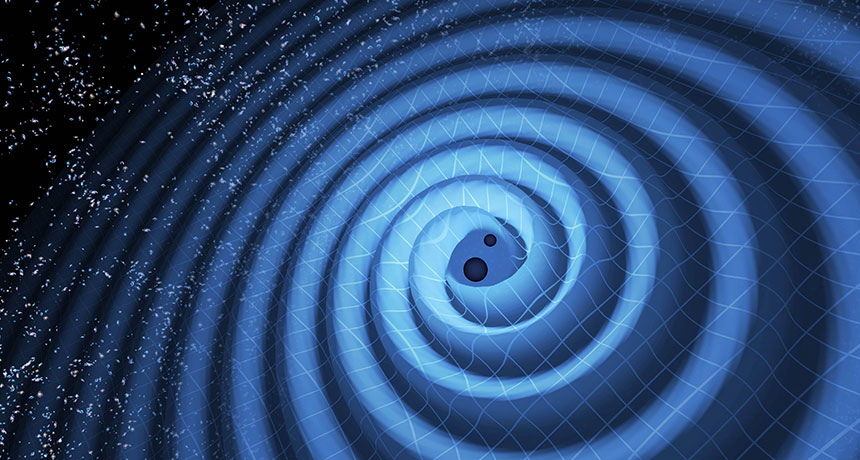Second gravitational wave signal detected

For the second time, scientists have glimpsed elusive ripples that vibrate the fabric of space. A new observation of gravitational waves, announced by scientists with the Advanced Laser Interferometer Gravitational-Wave Observatory, LIGO, follows their first detection, reported earlier this year (SN: 3/5/16, p. 6). The second detection further opens a new window through which to observe the universe.
“The era of gravitational wave astronomy is upon us,” says astronomer Scott Ransom of the National Radio Astronomy Observatory in Charlottesville, Va., who is not involved with LIGO. “Now that there’s two, you can’t get around that anymore.”
Both sets of cosmic quivers were wrought in cataclysmic collisions of black holes. But the latest observation indicates that such merging pairs of black holes are a varied bunch — the newly detected black holes were much smaller than the first pair. And this time, scientists concluded that one in the pair was spinning like a top.
“The most important thing is that it’s a second one,” says LIGO spokesperson Gabriela González of Louisiana State University in Baton Rouge. “But it’s important that it’s different, because it shows that there’s a spectrum of black hole systems out there.”
The two black holes in the most recent detection were about eight and 14 times the mass of the sun and were located roughly 1.4 billion light-years from Earth, the scientists estimate. When the pair fused, they formed one bloated black hole with a mass 21 times that of the sun. One sun’s worth of mass was converted into energy and carried away by the gravitational waves, LIGO scientists announced June 15 in San Diego during a meeting of the American Astronomical Society.
“Gravitational astronomy is real,” LIGO laboratory executive director David Reitze said in a news conference. “The future is going to be full of binary black hole mergers for LIGO.”
A paper describing the finding was published online June 15 in Physical Review Letters.
As the two black holes spiraled around each other and slammed together, they churned up cosmic undulations that stretched and squeezed space — as predicted by Einstein’s general theory of relativity. These waves careened across the universe, reaching LIGO’s twin detectors in Hanford, Wash., and Livingston, La., on December 26, 2015.
Each L-shaped LIGO detector senses the minuscule stretching and squeezing of space across its two 4-kilometer arms. As a gravitational wave passes through, one arm lengthens while the other shortens. Laser light bouncing back and forth in the arms serves as an ultrasensitive measuring stick that can pick up those subtle length changes (SN: 3/5/16, p. 22). As the gravitational waves rumbled past Earth in December, they stretched and squeezed the arms by less than a thousandth the width of a proton. “That’s very, very small,” González said. “That’s like changing the distance between Earth and the sun by a fraction of an atomic diameter.” This tiny deviation, appearing in both detectors nearly simultaneously, was enough to pick out the telltale ripples.
Compared with LIGO’s previously detected black hole merger, this one was a more minor dustup. These black holes were less than half the size of those in the first merger (30 and 35 solar masses according to a recently revised estimate). And the signal of their coalescence was more subtle, hiding under the messy wiggles in the data that result from random fluctuations or unwanted signals from the environment.
The first detection stunned scientists, due to the surprisingly large masses of the black holes and the whopping signals their gravitational waves left in the data. But the new black hole merger is more in line with expectations.
“This is comfort food,” says physicist Emanuele Berti of the University of Mississippi in Oxford, who is not involved with LIGO. “If you had asked me before the first detection, I would have bet that this would have been the first kind of binary black hole to be observed, not the monster we saw.”
There’s little question about whether the signal is real — a false alarm of this magnitude should occur only once in 200,000 years. “It’s very, very exciting,” says physicist Clifford Will of the University of Florida in Gainesville. It “looks like a very solid discovery.”
In a new twist, the scientists found that one of the two merging black holes was spinning. It was rotating at a speed at least 20 percent of its maximum possible speed. Using gravitational waves to study how pairs of black holes twirl could help scientists understand how they form.
The scientists used their data to put general relativity through its paces, looking for deviations from the theory’s predictions. But the black holes’ behavior was as expected.
LIGO also saw hints of a third black hole collision on October 12. The evidence was not strong enough to claim a definitive detection, though.
LIGO is currently offline, undergoing improvements that will allow the detectors to peer even further out into space. Scientists expect it to be back up and running this fall, churning out new detections of gravitational waves. “Now we know for sure that we’ll see more in the future,” González says.